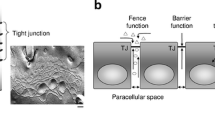Abstract.
The molecular architecture of tight junctions has been a subject of extensive studies that have shown tight junctions to be composed of many peripheral and integral membrane proteins. Claudins have been considered the main tight junction-forming proteins; however, the role they play in a series of pathophysiological events, including human carcinoma development, is only now beginning to be understood. Increasing evidence from in vitro and in vivo studies have identified the influence of claudins on tight junction structure and function, although claudins also participate in cellular contexts other than tight junctions. The aim of this review is to summarize and discuss the conceptual framework concerning claudins, focusing on the involvement of these proteins in epithelial cell polarity establishment, paracellular transport control, signal transduction and tumorigenesis.
Similar content being viewed by others
Author information
Authors and Affiliations
Corresponding author
Additional information
Received 5 July 2006; received after revision 29 August 2006; accepted 29 September 2006
Rights and permissions
About this article
Cite this article
Oliveira, S.S., Morgado-Díaz, J.A. Claudins: multifunctional players in epithelial tight junctions and their role in cancer. Cell. Mol. Life Sci. 64, 17–28 (2007). https://doi.org/10.1007/s00018-006-6314-1
Published:
Issue Date:
DOI: https://doi.org/10.1007/s00018-006-6314-1




